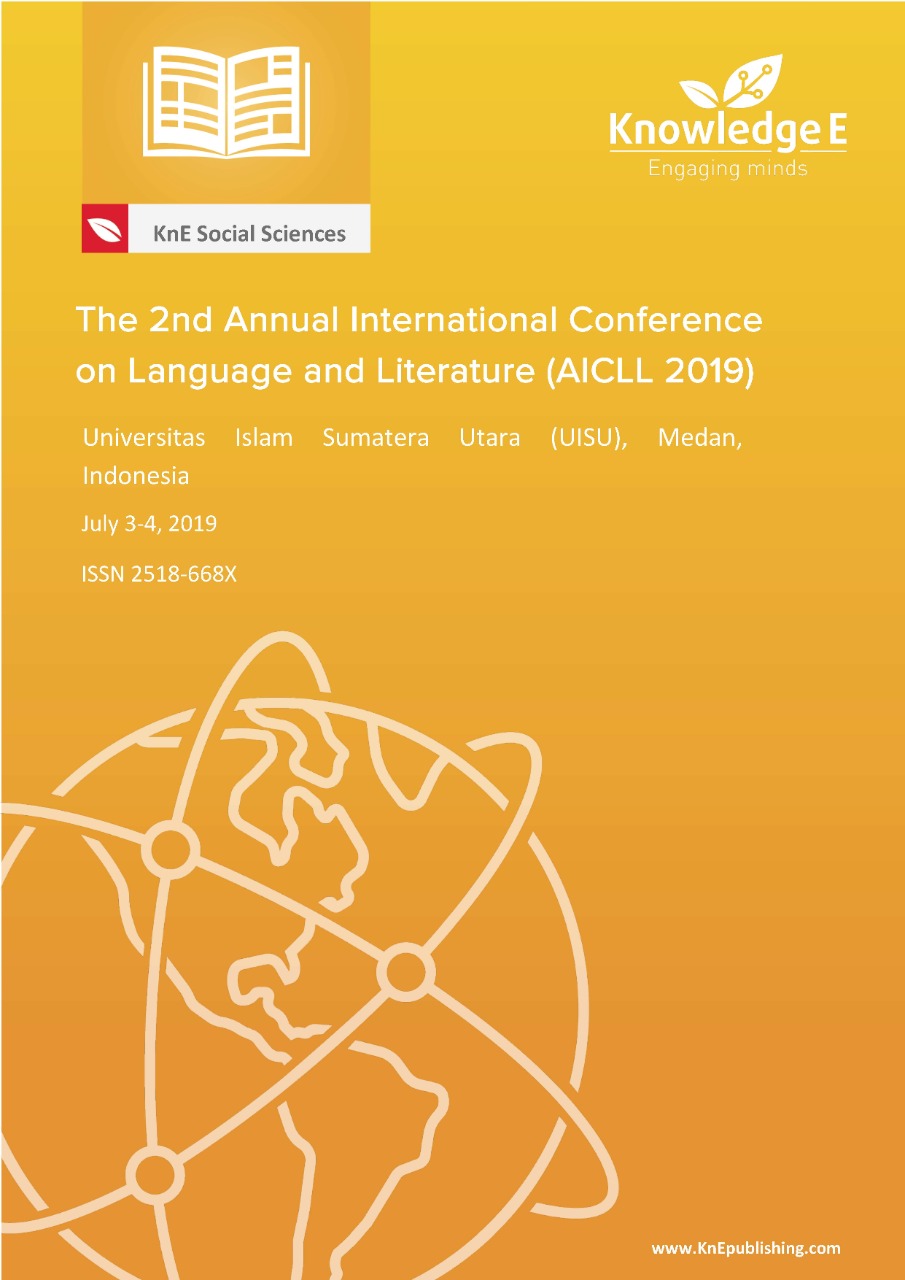Researching ELT 4.0 and Transmediality: Fostering Transliterate Reading through Transmedia Storytelling
DOI:
https://doi.org/10.18502/kss.v3i19.4888Abstract
The notion of Education 4.0 has directed to the utilization of various media platforms in teaching, which, in this context, is the adoption of Transmedia storytelling. Transmedia storytelling is the material presented to the students during the teaching and learning session that aims at fostering students transliterate reading. Through transmedia storytelling students are introduced to reading activities that enable them to read through multiple media platforms presented in class. A number of studies have been done in researching transmediality in the area of communication studies, however only little is known in ELT research. Therefore, this paper endeavors to explore the ways in which transmedia storytelling helps foster students’ transliterate reading. Adopting Transmedia Play and Storytelling theories grounded in transmediality, the paper utilizes a case study as the research design. Employing classroom observation and students’ response sheets, the findings reveal that transmedia storytelling promotes students transliterate reading through facilitating them in engaging with multiple types of visual, audio and interactive media activities. It helps them develop awareness in three areas: 1) awareness of the function of pictures for story comprehension and vocabulary acquisition; 2) awareness of the way sound helps for narrative elements interpretation; 3) awareness of the needs of text-reader transaction through new media for comprehension.
Keywords: Transmedia Storytelling, Transliterate Reading, media platforms
References
Allen, V. F. (1983). Techniques in teaching vocabulary. New York, N.Y.: Oxford University Press.
Alper, M. & Herr-Stephenson, R. (2013), ‘Transmedia play: Literacy across media’, Journal of Media Literacy Education, 5:2, 366–69.
Alwasilah. (2006). Perspektif Pendidikan Bahasa Inggris di Indonesia. Bandung: CV. Andira.
Avery, R. et al. (Ed.) (2000). English-Turkish Redhouse Dictionary. Istanbul: Sev Printing and Publishing.
Baarspul, M.P. (2012). Where transmedia storytelling goes wrong: A preliminary exploration of the issues with transmedia storytelling, Unpublished Master’s Thesis TFT. Retrieved from Utrecht University Repository.
Creswell, J.W. (2008) Educational research: Planning, conducting, and evaluating quantitative and qualitative research. Upper Saddle River, NJ: Pearson/Merrill Education.
Creswell, J. W. (2012). Educational research: Planning, conducting, and evaluating quantitative and qualitative research (4th ed.). Upper Saddle River, NJ: Pearson.
Elley, W. (1991). Acquiring literacy in a second language: The effect of book based programs. Language Learning 41, 375-411.
Elster, C. A. (1998). Influences of text and pictures on shared and emergent readings. Research in the teaching of English, 32(1), 43-78.
Fraenkel, J.R. & Wallen, N.E. (2009). How to Design and Evaluate Research in Education (7
Gall, M. D., Gall, J. P., & Borg, W. R. (2003). Educational research: An introduction (7
Gambarato, R., & Alzamora, G. C. (2012). Transmedia Storytelling Initiatives in Brazilian Media. Medien Journal, 4, 51-60. Retrieved from https://talkingobjects.files. wordpress.com/2012/01/Gambarato&Alzamora,2012_mj2012_4_bric.pdf
Jenkins, H. (2006). Convergence Culture: Where Old and New Media Collide. NY: NYU Press.
Jenkins, H. (2008). “Searching for the Origami Unicorn: The Matrix and Transmedia Storytelling,” Convergence Culture: Where Old and New Media Collide. New York : New York University Press. Pages 93–130.
Jenkins, H. (2010). Transmedia Storytelling and Entertainment. Continuum: Journal of Media & Cultural Studies, 24(6), 943–958. http://doi.org/Article
Juslin, Patrik & Västfjäll, Daniel. (2008). Emotional Responses to Music: The Need to Consider Underlying Mechanisms. The Behavioral and brain sciences. 31. 559-75; discussion 575. 10.1017/S0140525X08005293.
Juslin, P. N. & Sloboda, J. A., eds. (2001) Music and emotion: Theory and research. Oxford University Press
Kinder, M. (1991). Playing with Power In Movies, Television and Video Games. University of California Press, California.
Middleton, A 2009, ‘Beyond podcasting: creative approaches to designing education audio’, Alt-J, Research in Learning Technology, vol. 17, no. 2.
Munaro, A. C., & Vieira, A. M. D. P. (2016). Use of Transmedia Storytelling for Teaching Teenagers. Creative Education, 7, 1007-1017.
Phillips, A. (2012). A Creator’s Guide to Transmedia Storytelling: How to Captivate and Engage Audiences Across Multiple Platforms. Ney York: McGraw Hill.
Pitts, J., Ireton, D., & Ward, B. (2014). Beyond the book: teaching transliteracy through transmedia storytelling. LOEX Quarterly 41(3), 4-10.
Rodrigues, P., & Bidarra, J. (2014). Transmedia Storytelling and the Creation of a Converging Space of Educational Practices. International Journal of Engineering and Technology (iJET), 9, 42-48.
Rodrigues, P., & Bidarra, J. (2018). Transmedia Storytelling as a Framework for Effective Blended Learning Design. In The Envisioning Report for Empowering Universities. Eds. G. Urbachs & L. Konings. Lisbon: EADTU
Scrivener, J. (2005) Learning teaching: a guidebook for English language teachers. 2nd ed. Oxford: MacMillan.
Scolari, C.A (2009) “Transmedia Storytelling: Implicit Consumers, Narrative Worlds and Branding in Contemporary Media Production”. International Journal of Communication 3, pp. 586-606
Scolari, C. A. (2014). Transmedia storytelling: New ways of communicating in the digital age. The International Journal of Multimedia & Its Applications (IJMA, 8(6).
Sinambela, S.E. & Saragih, A. (2018), “Promoting Hots and Better Literacy for EFL Students through the Cognitively Challenging Reading Material” in The 1st Annual International Conference on Language and Literature, KnE Social Sciences, pages 806–815. DOI 10.18502/kss.v3i4.1987
Shipka, J. (2016). Transmodality In/And Processes of Making: Changing Disposition and Practice. College English, 78(3)
Singh, Y. K. (2005) Instructional Technology in Education, New Delhi: Darya Gani
Stornaiuolo, A., Smith, A., & Phillips, N. (2017). Developing a transliteracies framework for a connected world. Journal of Literacy Research, 49, 68–91.
Sukovic, S. (2014). iTell: Transliteracy and Digital Storytelling. Australian Academic & Research Libraries, 45(3), 205–229.
Thomas, S., et. al. (2007, December 3). Transliteracy: Crossing divides. First Monday 12(12). Retrieved from http://firstmonday.org/article/view/2060/1908
Wright, A. (1989) Pictures for language learning. New York: Cambridge University Press.

